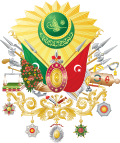Sanjak of Dibra
| Sanjak of Dibra Debre Sancağı Sanxhaku i Dibrës Дебарски санџак | |||||||||
|---|---|---|---|---|---|---|---|---|---|
| Sanjak of the Ottoman Empire | |||||||||
| 1395–1913 | |||||||||
 | |||||||||
| Capital | Debar | ||||||||
| History | |||||||||
• Established | 1395 | ||||||||
• Treaty of London (1913) | 30 May 1913 | ||||||||
| |||||||||
| Today part of | Albania North Macedonia | ||||||||
| History of Albania |
|---|
 |
| Timeline |
The Sanjak of Dibra, Debar, or Dibër (
).Extent and subdivisions
Besides Debar, the territory of the Sanjak of Dibra included part of northern
Since the mid-19th century, the Sanjak of Dibra had consisted of two kazas: Debar and Reka.[5] By the time of its dissolution in 1912, it had four kazas: Debar, Reka, Mat and Lower Dibra.[6]
Culture and demographics
In the late Ottoman period, the Sanjak of Dibra had a population of 200,000. Debar, the main town and capital, had 20,000 inhabitants, 420 shops, 9
Albanian tribes known as the "Tigers of Dibra" held power in the mountainous areas of the sanjak, along with much of the valley. These tribes, known as malësorët (highlanders), were mostly
One of the largest tribes of the malësorët was the Mati tribe, numbering 1,200 households. One of the most prominent of the Mati families were the Zogolli, who are most notable for being the clan from which
By the 1880s, the Sanjak of Dibra was classified linguistically and culturally as part of
Administrative mergers (Vilayets)
In 1867, the Sanjak of Dibra merged with the
The Sanjak of Dibra was separated from the Kosovo Vilayet and joined to the
Dissolution
On 4 September 1912, the successful Albanian Revolt of 1912 led to part of the Sanjak of Dibra being permitted to move to the newly proposed Albanian Vilayet, as a result of the Revolt's demand for greater autonomy. However, the Albanian Vilayet would not be realized, due to the outbreak of the First Balkan War (1912-1913), one month later.
During the First Balkan War, the Sanjak of Dibra was occupied by the Kingdom of Serbia, along with the rest of the sanjaks set to become the proposed Albanian Vilayet. Due to the occupation, Albanian leaders petitioned Emperor Franz Joseph I of Austria-Hungary for support for Albania's independence, but all he conceded was support for Albanian autonomy within the Ottoman Empire.
Despite this, in 1912 Independent Albania was declared at the All-Albanian Congress, and it petitioned the London Conference of 1913 for recognition on the basis of the ethnic rights of Albanians, but its claims of wider sovereignty were ignored.
In the Treaty of London (1913), many of the Albanian sanjaks were partitioned between the Kingdom of Greece, the Kingdom of Montenegro, and the Kingdom of Serbia.[13] Consequently, the Sanjak of Dibra was dissolved, and its territory was divided between Serbia and the newly established Principality of Albania.
Governors
- Skanderbeg (1440–November 1443)
- Moisi Golemi (1455–?)
- Abdullah Pasha (fl. 1897)[14]
References
- ISBN 978-1-86064-974-5.
Dibra and its surrounding became separate sanjak
- ^ Zhelyazkova, Antonina. "Albanian identities" (PDF). Retrieved 3 April 2011.
portion of the north Albanian lands was included in the sancak of Debar, namely Kruja, Debar and the areas lying between the rivers of Mat and Black Drin
- ^ Zhelyazkova, Antonina. "Albanian identities". Archived from the original on 15 May 2011.
In 1440, he was promoted to sancakbey of Debar
- ISBN 978-0-8448-0072-1.
- ^ Aleksandar Matkovski (1959). Ǧurčin Kokaleski. p. 73.
..До првата половина на XIX век „Деборија" админи- стративно припаѓала во Дебарскиот пашалак, покасно кон Дебарскиот санџак (дебре - санџаги) кој се делел на Дебарска каза со седиште во дебар и на Реканска каза со
- ^ Ivan Ivanić (1910). Maćedonija i maćedondži. Štampa Savića i Komp. p. 30.
Дебарски санџак има четири казе: Дебарску, матску, доњодебарску и речку (Река)
- ^ ISBN 9781845112875.
- ^ Gawrych 2006, pp. 34–36.
- ISBN 90-04-11903-5.
the vilayet of Prizren was founded in 1871
- ISBN 978-1-84885-477-2.
In 1868 the vilayet of Prizren was created with the sancaks of Prizren, Dibra, Skopje and Niš; it only existed till 1877
- ^ Apostoloski, Mihailo (1978). Makedonija vo istočnata kriza 1875–1881. Skopje: Makedonska akademija na naukite i umetnostite. p. 187.
After the Berlin Congress other administrative reforms were carried out. So the Debar Sanjak was separated from Kosovo Vilayet and was added to the Bitola vilayet...
- ^ Brastvo. Društvo sv. Save. 1940. p. 176.
Уопште Дебарски санџак се, у последње време до осло- бођења, трговачким артиклима са 50°/» снабдевао из Скопља а са 25°/» из Битоља.
- ISBN 978-1-86064-541-9.
- ^ British and Foreign State Papers. H.M. Stationery Office. 1897.

